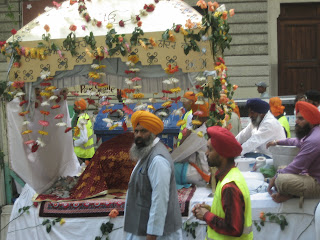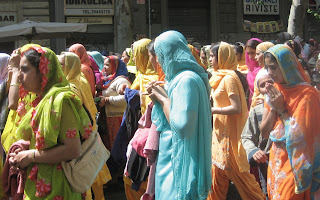
At the vanguard of the procession came a truck spraying water onto the street, followed by a small army of sweepers...

... because some of those marching in the procession were barefoot.

After them came these impressive fellows.

Sure, we have the fullness of faith, but I think we do have something to learn from our Sikh brethren... We Catholics should consider the greater liturgical use of swords.

Next came this float.

and after the float, these Sikh women in colourful dress.
Anyone out there knowing anything about Sikhism is welcome to comment on the significance of the various costumes, etc...
8 comments:
Guru Nanak was certainly a character! He commanded his followers not to cut their hair and always to have a sword ready... I agree, these should have more prominence in our own liturgy. Heh. As regards the dress, if I remember my Asian History correctly, Sikhism drew from both Islam and Hinduism-- it professed belief in One God but also adopted some Hindu influences. Perhaps the dresses are the obvious result of the fusion of the two? More Catholic women need to dress like this, IMO, the 'Amish country gal' look that many emulate is just... boring.
Sikh men must always have a sword on them. . . even when swimming! (knowledge accumulated from my experience as a lifeguard. . . and yes, they're allowed to wear their swords into the water even in public swimming pools. . .)
In America we have the Knights of Columbus to provide swords for liturgies.
I had forgotten about the Knights!
Anyway, that is fascinating about the Sikhs always having swords to hand.
Swimming with swords...sounds cumbersome. I don't suppose they do synchronized swimming?
I bet these guys use swords and armor.
www.heralds.ca
www.knightsoftheholyeucharist.com
Nanak described God's revelation—the path to salvation—with terms such as nām (the divine Name) and śabad (the divine Word) to emphasise the totality of the revelation. Nanak designated the word guru (meaning teacher) as the voice of God and the source and guide for knowledge and salvation.[10] Salvation can be reached only through rigorous and disciplined devotion to God. Nanak distinctly emphasised the irrelevance of outwardly observations such as rites, pilgrimages or asceticism. He stressed that devotion must take place through the heart, with the spirit and the soul.
A key practice to be pursued is nām simraṇ: remembrance of the divine Name. The verbal repetition of the name of God or a sacred syllable is an established practice in religious traditions in India, but Nanak's interpretation emphasised inward, personal observance. Nanak's ideal is the total exposure of one's being to the divine Name and a total conforming to Dharma or the "Divine Order". Nanak described the result of the disciplined application of nām simraṇ as a "growing towards and into God" through a gradual process of five stages. The last of these is sac khaṇḍ (The Realm of Truth)—the final union of the spirit with God.[10]
Nanak stressed kirat karō: that a Sikh should balance work, worship, and charity, and should defend the rights of all creatures, and in particular, fellow human beings. They are encouraged to have a caṛdī kalā, or optimistic, view of life. Sikh teachings also stress the concept of sharing—vaṇḍ chakkō—through the distribution of free food at Sikh gurdwaras (laṅgar), giving charitable donations, and working for the betterment of the community and others (sēvā).
Baptised Sikhs are bound to wear the Five Ks (in Punjabi known as pañj kakkē or pañj kakār), or articles of faith, at all times. The tenth guru, Gobind Singh, ordered these Five Ks to be worn so that a Sikh could actively use them to make a difference to their own and to others' spirituality. The 5 items are: kēs (uncut hair), kaṅghā (small comb), kaṛā (circular heavy metal bracelet), kirpān (ceremonial short sword), and kacchā (special undergarment). The Five Ks have both practical and symbolic purposes.[41]
Post a Comment